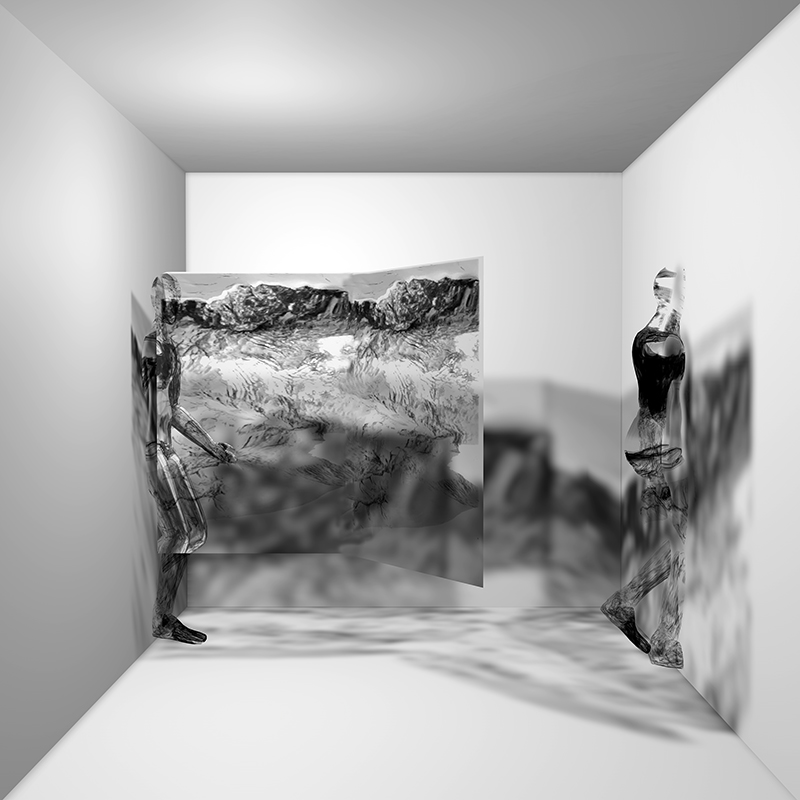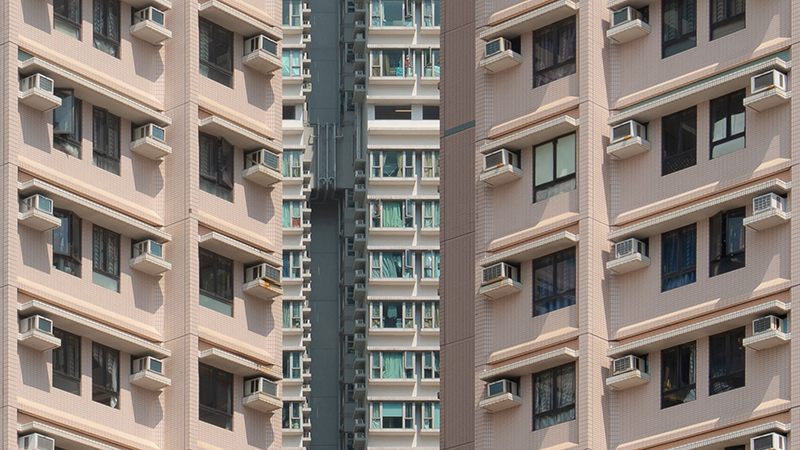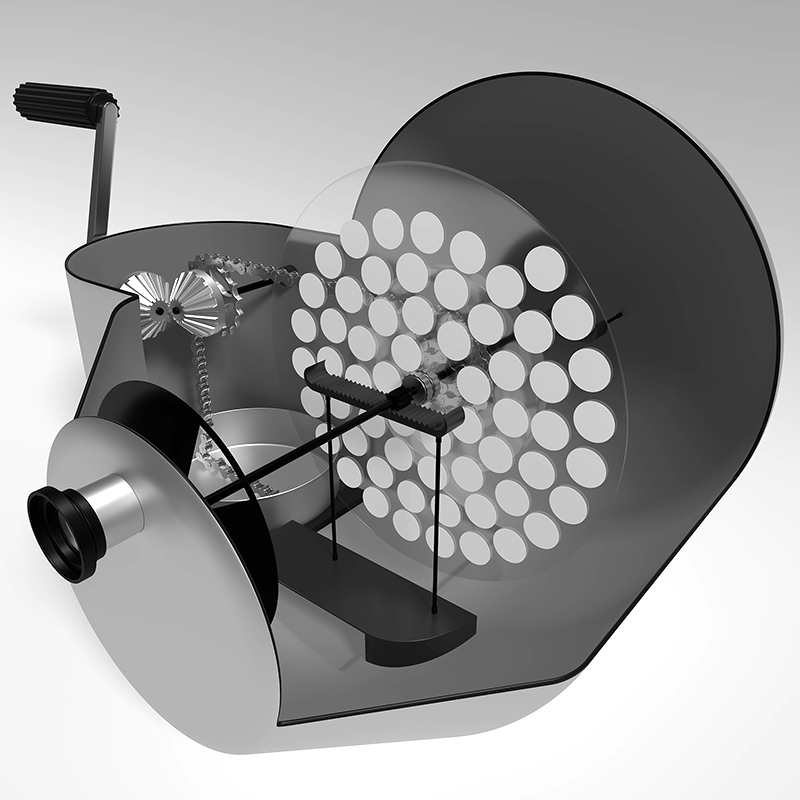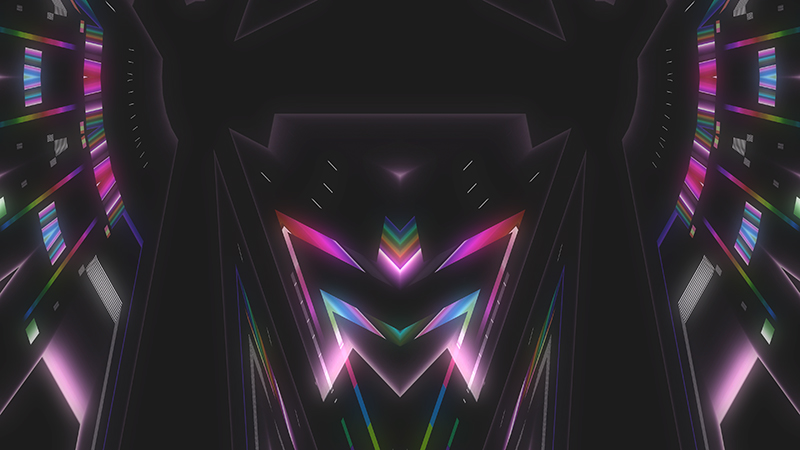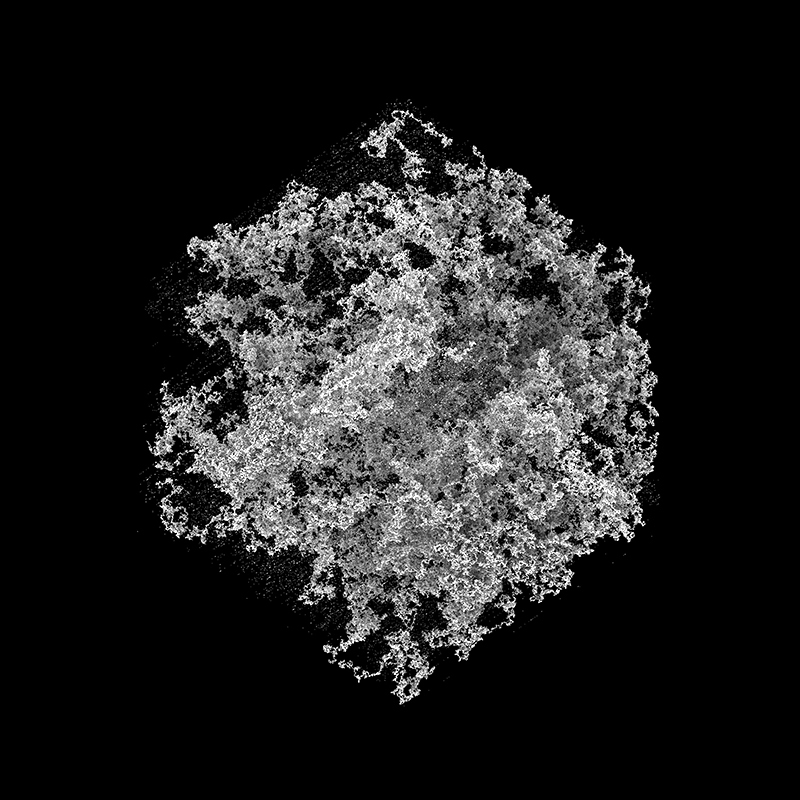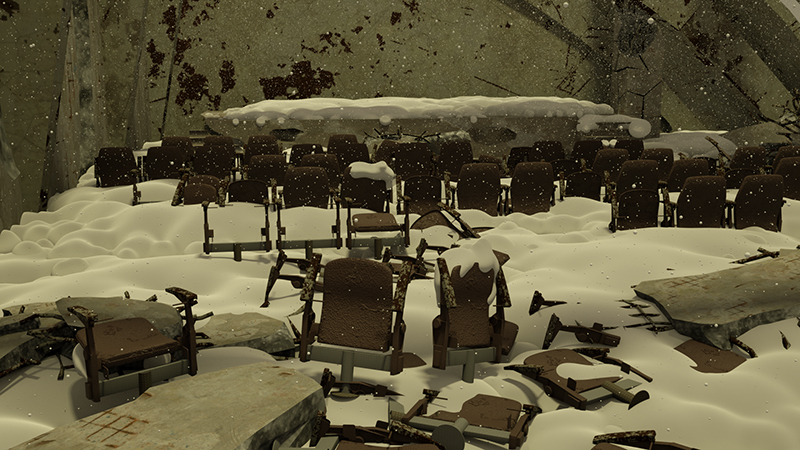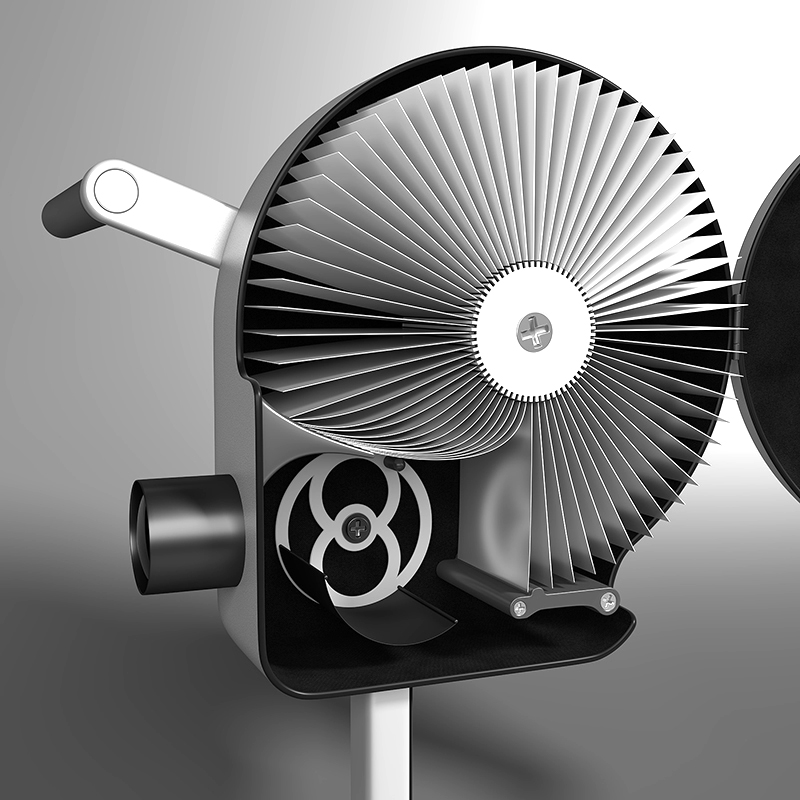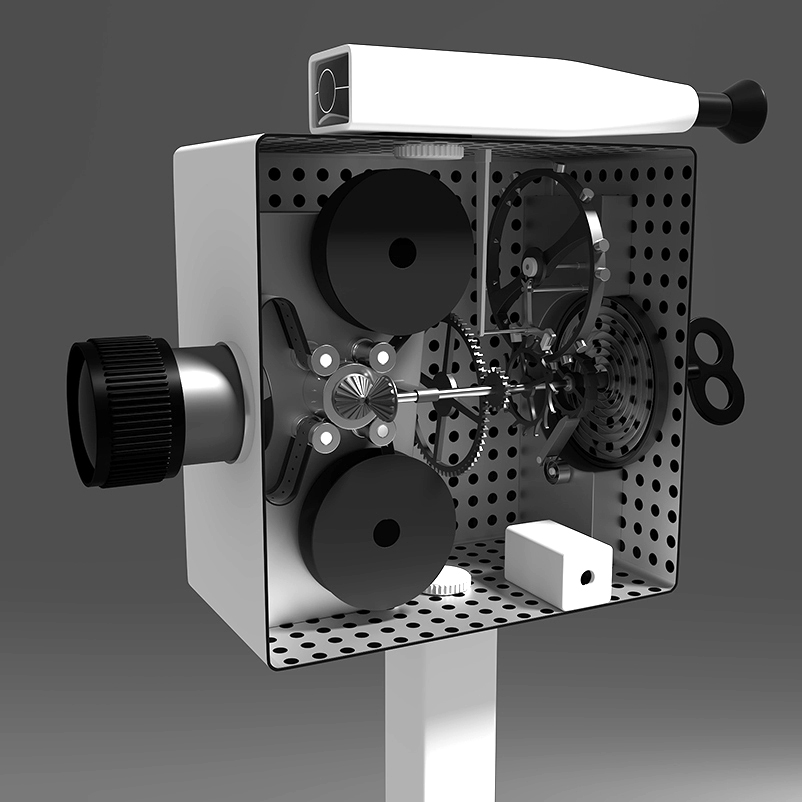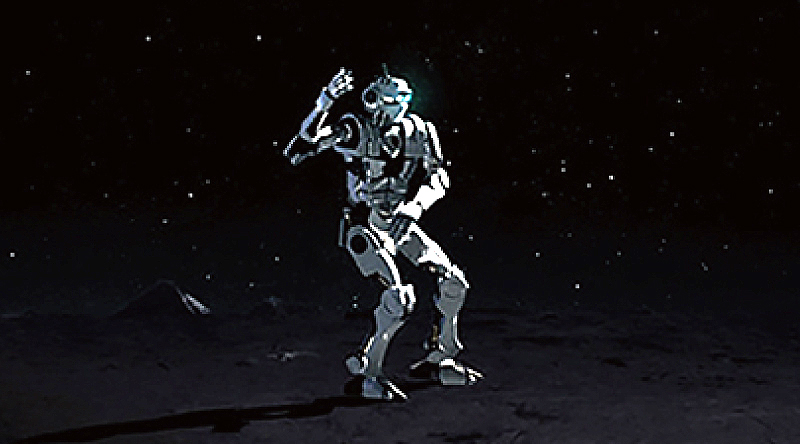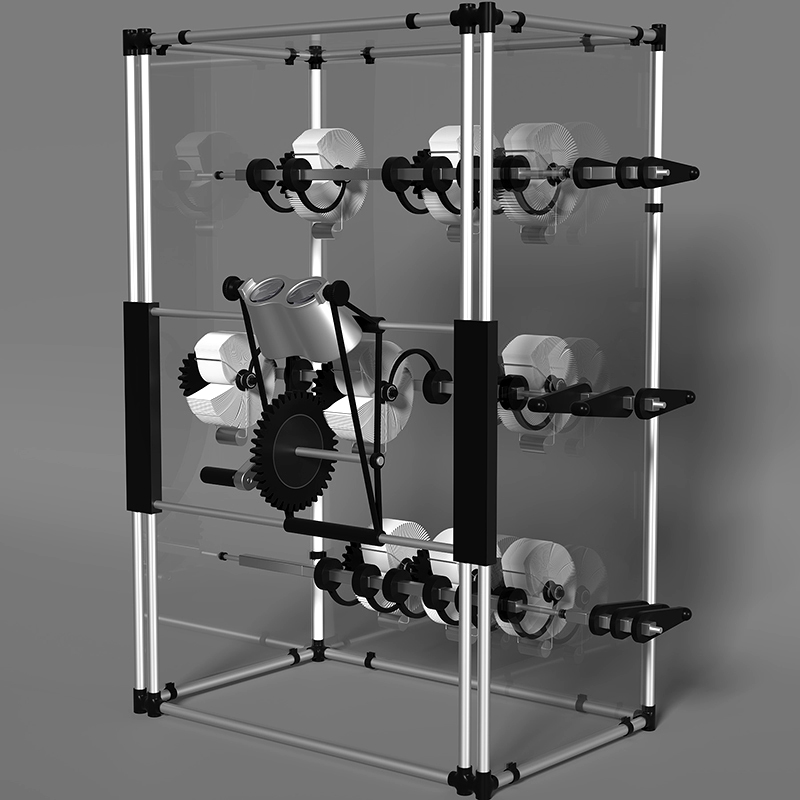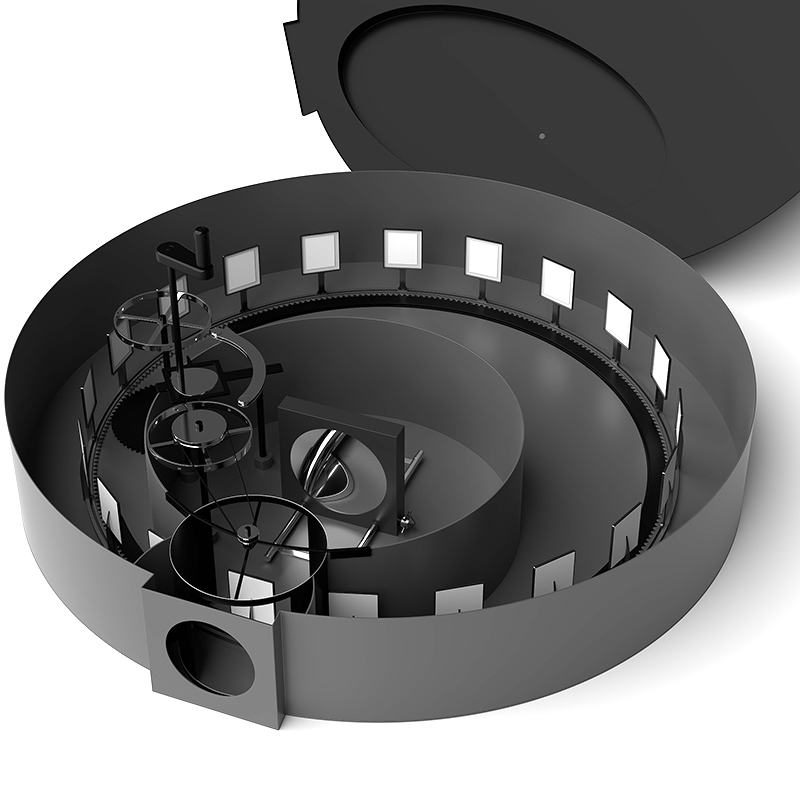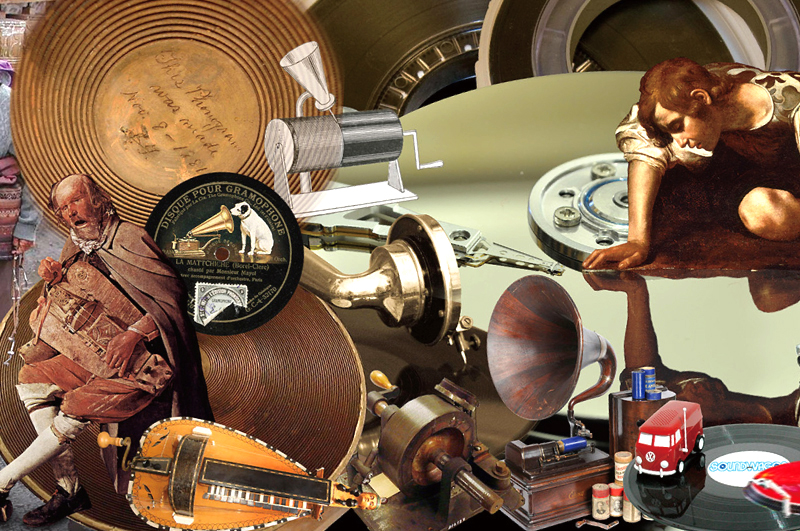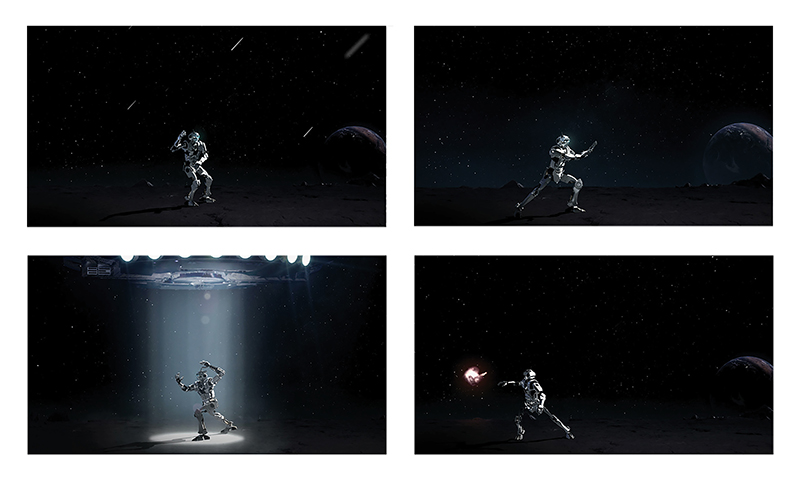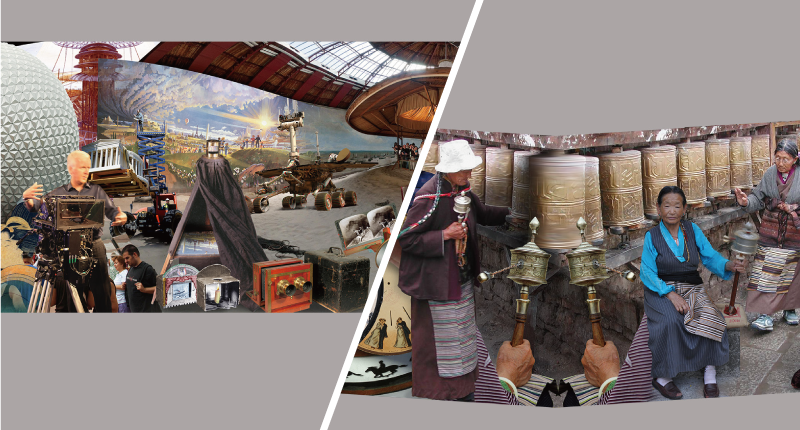A computer is a machine that can be programmed to carry out a sequence of logical operations and in computer art, the artist, or collaborator, engineers the computer’s capacities (via programming) to achieve artistically distinctive ends. Computer engineers and mathematicians were among the first to apply computer to artmaking in the 1960s, when large computers first became available. Research labs, such as Bell Labs in New Jersey, USA, brought artists and computer scientists together to collaborate on developing computer graphics and animation. Since then, with the development of personal computers and graphics workstations, the fields have grown exponentially. This exhibition focuses upon achievements in abstract art.
ⓘ To visit the exhibition please click here to register.
Explore the Objects
Computer Graphics and Animation
Carla Chan
I Clone your Digital Soul, 2020
Acrylic on canvas
I Clone your Digital Soul is a series of paintings done using a custom-made, 3-dimensional spraying machine. The work explores such questions as, "do art machines then possess a “soul?”, demonstrating that the process of using machines to make art has unexpected outcomes, which support the belief in the possibilities of a creative path beyond that made by an individual act.
Max Hattler
Serial Parallels, 2019
Photographic still from video
This experimental portrait of Hong Kong approaches the city’s built environment from the conceptual perspective of celluloid film, by applying the technique of film animation to the photographic image. Hong Kong’s signature architecture of horizon-eclipsing housing estates is reimagined as parallel rows of film strips: Serial Parallels.
Tamás Waliczky
Spiral Camera, 2016/2018
Computer graphic digital inkjet print on Hahnemuhle paper, 119 x 84 cm
Glass-plate cameras were only manufactured for a short time and fascinated me. I could not tell how they were built and imagined my own. This camera records films of a couple of seconds onto the small, circular photo papers, stuck in spiral form on the central glass plate. The glass plate must not only rotate, but as the recording proceeds, must also move horizontally.
Max Hattler
Voertex, 2020
Concept art for video
Vœrtex is part of Max Hattler’s ongoing artistic research into expanded stereoscopy: techniques and processes which employ binocular vision in unconventional ways to create spaces where depth relations are disjointed and paradoxical, where binocular rivalry is used to create unique visual effects, or where new dimensionality and visual intensity are excavated from flat source material.
Mike K. M. Wong
Simplexity 02, 2020
Computer-generated image (Inkjet print)
Simplexity 02 features a photo-realistic rendering of an imaginary organic structure which is grown using an experimental space filling algorithm. This work belongs to an on-going generative art project by the artist that explores how visual complexity emerges through various iterative processes.
Tamás Waliczky
Muybridge Camera, 2017/2018
Computer graphic digital inkjet print on Hahnemuhle paper, 119 x 84 cm
This camera is named after Eadweard Muybridge, the first who was able to record motion, using 24 sequential photographs of a galloping horse. This camera has 12 lenses in a long row in the front, with a slider visible on top, with which I can take photos in sequence.
Vvzela Kook
Orzersk Machine, 2020
Mixed media
Orzersk Machine is a virtual machine that is built to give effective solutions to given situations such as man-made disasters or political scandals. The “disinfected” information leads to a Skazochnyi (Russian: fairy-tale) dystopia which, however, functions as an elysium for the authorities.
Tamás Waliczky
Flipbook Camera, 2016/2018
Computer graphic digital inkjet print on Hahnemuhle paper, 119 x 84 cm
The flipbook records 3-4 seconds of film onto postcard size sheet-film. The camera is a wheel-shaped structure drive by a crank. A sheet faces the light streaming in through the lens, records the image while a barrier delays the placement of the next sheet until ready.
Tamás Waliczky
Clockwork Camera, 2017/2018
Computer graphic digital inkjet print on Hahnemuhle paper, 119 x 84 cm
This camera is inspired by clockworks. Early cameras like mechanical clocks had a periodic motion with the second-hand jumping ahead and then stopping, just like the conveyance of film; both used spring motors that needed to be wound. Here I have created camera that needs to be wound just like a clock.
anothermountainman (Stanley Wong)
back to the future / tai chi, 2014
2014 / video / 6'27"
This video work features a robot who, it seems, is alone, at the end of the world performing his Tai Chi. The movements of the robot were created by the motion capture of a real Tai Chi master and thus the work represents a true synthesis of man and machine, just as Tai Chi itself embodies the synthesis between the yin and the yang.
Tamás Waliczky
Flipbook Jukebox, 2018
Computer graphic digital inkjet print on Hahnemuhle paper, 119 x 84 cm
The flipbook is the original version of the moving image; here I was experimenting with a machine that could play longer films with the flipbook technique. The design allows you to move freely among the various scenes, by moving the viewer on the central band in an interactive non-linear manner, similar to that of a jukebox.
Tamás Waliczky
Mirror Camera, 2017/2018
Computer graphic digital inkjet print on Hahnemuhle paper, 119 x 84 cm
This design is based on Alexander Wolcott’s camera that only uses light entering through a hole, reflected by a central concave mirror onto light-sensitive paper. But whereas Wolcott used one small paper after another for individual photos, here the photo papers stand in a circle and can be rotated by moving an arm at the top to create a film.
Tjebbe van Tijen
SCMURAL, 2011
Digital montage, printed
This massive mural encompasses the history of technologies and media used for making art and communicating through the ages. It ranges from Chinese shadow puppets and scroll painting, through the magic lantern and stereoscopic viewfinders, to James Cameron’s 3D rig for Avatar and Shaw’s AR artwork, The Golden Calf. The scroll made a study of what van Tijen called “pre-cinematic” principles, not in the form of an academic study but as an associative montage that combines both visual links between different elements, and formal resonances between images.
Carla Chan
I Clone your Digital Soul, 2020
Acrylic on canvas
I Clone your Digital Soul is a series of paintings done using a custom-made, 3-dimensional spraying machine. The work explores such questions as, "do art machines then possess a “soul?”, demonstrating that the process of using machines to make art has unexpected outcomes, which support the belief in the possibilities of a creative path beyond that made by an individual act.
X
<
>
Max Hattler
Serial Parallels, 2019
Photographic still from video
This experimental portrait of Hong Kong approaches the city’s built environment from the conceptual perspective of celluloid film, by applying the technique of film animation to the photographic image. Hong Kong’s signature architecture of horizon-eclipsing housing estates is reimagined as parallel rows of film strips: Serial Parallels.
X
<
>
Tamás Waliczky
Spiral Camera, 2016/2018
Computer graphic digital inkjet print on Hahnemuhle paper, 119 x 84 cm
Glass-plate cameras were only manufactured for a short time and fascinated me. I could not tell how they were built and imagined my own. This camera records films of a couple of seconds onto the small, circular photo papers, stuck in spiral form on the central glass plate. The glass plate must not only rotate, but as the recording proceeds, must also move horizontally.
X
<
>
Max Hattler
Voertex, 2020
Concept art for video
Vœrtex is part of Max Hattler’s ongoing artistic research into expanded stereoscopy: techniques and processes which employ binocular vision in unconventional ways to create spaces where depth relations are disjointed and paradoxical, where binocular rivalry is used to create unique visual effects, or where new dimensionality and visual intensity are excavated from flat source material.
X
<
>
Mike K. M. Wong
Simplexity 02, 2020
Computer-generated image (Inkjet print)
Simplexity 02 features a photo-realistic rendering of an imaginary organic structure which is grown using an experimental space filling algorithm. This work belongs to an on-going generative art project by the artist that explores how visual complexity emerges through various iterative processes.
X
<
>
Tamás Waliczky
Muybridge Camera, 2017/2018
Computer graphic digital inkjet print on Hahnemuhle paper, 119 x 84 cm
This camera is named after Eadweard Muybridge, the first who was able to record motion, using 24 sequential photographs of a galloping horse. This camera has 12 lenses in a long row in the front, with a slider visible on top, with which I can take photos in sequence.
X
<
>
Vvzela Kook
Orzersk Machine, 2020
Mixed media
Orzersk Machine is a virtual machine that is built to give effective solutions to given situations such as man-made disasters or political scandals. The “disinfected” information leads to a Skazochnyi (Russian: fairy-tale) dystopia which, however, functions as an elysium for the authorities.
X
<
>
Tamás Waliczky
Flipbook Camera, 2016/2018
Computer graphic digital inkjet print on Hahnemuhle paper, 119 x 84 cm
The flipbook records 3-4 seconds of film onto postcard size sheet-film. The camera is a wheel-shaped structure drive by a crank. A sheet faces the light streaming in through the lens, records the image while a barrier delays the placement of the next sheet until ready.
X
<
>
Tamás Waliczky
Clockwork Camera, 2017/2018
Computer graphic digital inkjet print on Hahnemuhle paper, 119 x 84 cm
This camera is inspired by clockworks. Early cameras like mechanical clocks had a periodic motion with the second-hand jumping ahead and then stopping, just like the conveyance of film; both used spring motors that needed to be wound. Here I have created camera that needs to be wound just like a clock.
X
<
>
anothermountainman (Stanley Wong)
back to the future / tai chi, 2014
2014 / video / 6'27"
This video work features a robot who, it seems, is alone, at the end of the world performing his Tai Chi. The movements of the robot were created by the motion capture of a real Tai Chi master and thus the work represents a true synthesis of man and machine, just as Tai Chi itself embodies the synthesis between the yin and the yang.
X
<
>
Tamás Waliczky
Flipbook Jukebox, 2018
Computer graphic digital inkjet print on Hahnemuhle paper, 119 x 84 cm
The flipbook is the original version of the moving image; here I was experimenting with a machine that could play longer films with the flipbook technique. The design allows you to move freely among the various scenes, by moving the viewer on the central band in an interactive non-linear manner, similar to that of a jukebox.
X
<
>
Tamás Waliczky
Mirror Camera, 2017/2018
Computer graphic digital inkjet print on Hahnemuhle paper, 119 x 84 cm
This design is based on Alexander Wolcott’s camera that only uses light entering through a hole, reflected by a central concave mirror onto light-sensitive paper. But whereas Wolcott used one small paper after another for individual photos, here the photo papers stand in a circle and can be rotated by moving an arm at the top to create a film.
X
<
>
Tjebbe van Tijen
SCMURAL, 2011
Digital montage, printed
This massive mural encompasses the history of technologies and media used for making art and communicating through the ages. It ranges from Chinese shadow puppets and scroll painting, through the magic lantern and stereoscopic viewfinders, to James Cameron’s 3D rig for Avatar and Shaw’s AR artwork, The Golden Calf. The scroll made a study of what van Tijen called “pre-cinematic” principles, not in the form of an academic study but as an associative montage that combines both visual links between different elements, and formal resonances between images.
X
<
>

